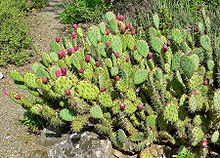Sabra fruit
| Opuntia | |
|---|---|
 |
|
| Opuntia littoralis var. vaseyi | |
| Scientific classification | |
| Kingdom: | Plantae |
| (unranked): | Angiosperms |
| (unranked): | Eudicots |
| (unranked): | Core eudicots |
| Order: | Caryophyllales |
| Family: | Cactaceae |
| Subfamily: | Opuntioideae |
| Tribe: | Opuntieae |
| Genus: |
Opuntia Mill. |
| Species | |
|
Many, see text. |
|
| Synonyms | |
and see text |
|
| Nutritional value per 100 g (3.5 oz) | |
|---|---|
| Energy | 172 kJ (41 kcal) |
|
9.6 g
|
|
| Dietary fiber | 3.6 g |
|
0.5 g
|
|
|
2.5 g
|
|
| Vitamins | |
| Vitamin A equiv. |
(3%)
25 μg |
| Riboflavin (B2) |
(8%)
0.1 mg |
| Niacin (B3) |
(3%)
0.5 mg |
| Vitamin B6 |
(8%)
0.1 mg |
| Folate (B9) |
(2%)
6 μg |
| Vitamin C |
(17%)
14.0 mg |
| Vitamin E |
(0%)
0 mg |
| Minerals | |
| Calcium |
(6%)
56 mg |
| Iron |
(2%)
0.3 mg |
| Magnesium |
(24%)
85 mg |
| Phosphorus |
(3%)
24 mg |
| Potassium |
(5%)
220 mg |
| Zinc |
(1%)
0.1 mg |
|
|
|
|
|
| Percentages are roughly approximated using US recommendations for adults. Source: USDA Nutrient Database |
|
Many, see text.
and see text
Opuntia is a genus in the cactus family, Cactaceae.
The most common culinary species is the Indian fig opuntia (O. ficus-indica). Most culinary uses of the term "prickly pear" refer to this species. Prickly pears are also known as tuna (fruit), sabra, nopal (paddle, plural nopales) from the Nahuatl word nōpalli for the pads, or nostle, from the Nahuatl word nōchtli for the fruit; or paddle cactus.
The genus is named for the Ancient Greek city of Opus, where, according to Theophrastus, an edible plant grew which could be propagated by rooting its leaves.
Like all true cactus species, prickly pears are native only to the Americas, but they have been introduced to other parts of the globe. Prickly pear species are found in abundance in Mexico, especially in the central and western regions, and in the Caribbean islands (West Indies). In the United States, prickly pears are native to many areas of the arid Western United States, including the lower elevations of the Rocky Mountains, where species such as Opuntia phaeacantha and Opuntia polyacantha become dominant, and to the desert Southwest, where several types are endemic. Prickly pear cactus is also native to coastal beach scrub environments and low open areas of the East Coast from Florida to Connecticut/Long Island (Opuntia humifusa).
Opuntia species are the most cold-tolerant of the lowland cacti, extending into western and southern Canada; one subspecies, O. fragilis var. fragilis, has been found growing along the Beatton River in central British Columbia, southwest of Cecil Lake at 56° 17’ N latitude and 120° 39’ W longitude. Prickly pears also produce a fruit, commonly eaten in Mexico and in the Mediterranean region, known as tuna; it also is used to make aguas frescas. The fruit can be red, wine-red, green, or yellow-orange.
...
Wikipedia
